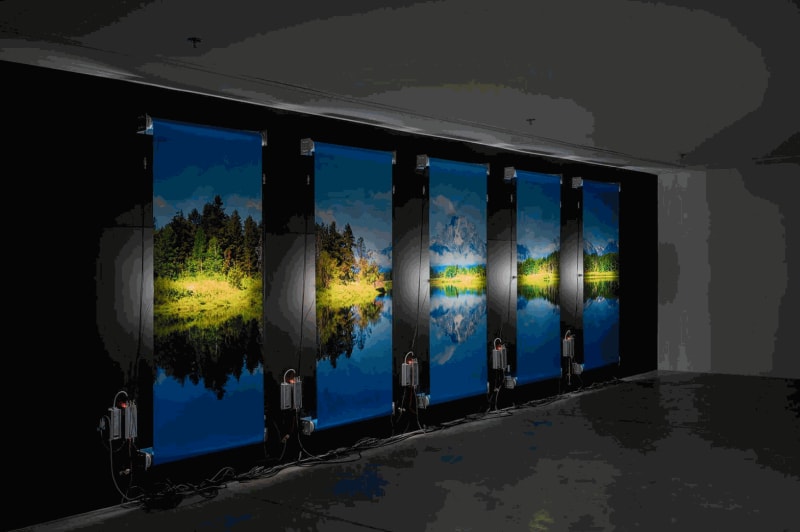In ‘Departure’ at Abigail Ogilvy Gallery, the Boston artist uses motorized scrolls — the kind that rotate ads in bus shelters — to show eerie, shifting landscapes.
The mountain vista Clint Baclawski depicts in “Departure” at Abigail Ogilvy Gallery is anything but serene. He inverts the mountain, he bathes it in lurid color. The image scrolls endlessly, staving off stillness.
The Boston artist is known for installations of photo transparencies wrapped around columnar light bulbs and set against mirrors. “Departure” experiments with a new format: eight-foot-tall motorized scrolls, ordinarily used to vertically rotate ads in bus shelters.
Baclawski studied advertising as an undergraduate at Rochester Institute of Technology. Here, he amps up an advertising format and exposes its bells and whistles.
Five scrolls side by side span 25 feet. Baclawski’s photograph of a mountain and its reflection in a lake at Grand Teton National Park is printed across the scrolls and backlit along the center. In the darkened gallery, it’s breathtaking.

The scrolls roll, nakedly outfitted with wires and electrical boxes. The image spins, and Baclawski cycles through color schemes. Even the most ordinary palette — blue sky, blue water, green foliage — is alarmingly high-keyed. The others are more monochromatic: green, yellow, red, black-and-white. The landscape seems to burn, sicken, and char. The black-and-white version reads like the husk of something once alive.
Baclawski, an identical twin, has used mirrors in his art for years, exploring likeness and identity. That shows up here in the mountain’s reflection. In each successive landscape, he flips the image. The mountain is crisp; the reflection shimmers and bleeds. The effect is destabilizing — what’s up? What’s down? — as is the constant scrolling and the shifting color schemes. There is no place to rest.

Works by Hudson River School painters such as Thomas Cole and Albert Bierstadt gloried in the sublime American landscape — how awesome and fearsome the wild was; how it dwarfed humans. Such paintings showed us our proper size. Advertising does the opposite: It makes us and our wants all-important. Ads distract us from our feet-on-the-ground experience of this life, this land.
Skewing the Grand Tetons through advertising’s lens, and then ratcheting up the discomfort with color and endless mechanical motion, Baclawski makes a dystopian rhyme with Hudson River School paintings. As the climate collapses, “Departure” is a stinging critique of a market-driven economy that has put greed ahead of care. It is a dark ode to the earth.
CLINT BACLAWSKI: DEPARTURE
At Abigail Ogilvy Gallery, 460 Harrison Ave., through Oct. 16. 617-820-5173, www.abigailogilvy.com
